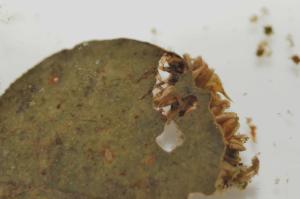Welcome

I'm glad you found your way to my master project website! My project revolves around an insect order that fly fishers are usually more accustomed to than biologists - the caddis flies (Trichoptera). They are not flies. In fact, they're closest related to moths but they're a complately different order. In Swedish they're called "nattsländor" which makes people thing of dragonflies (which are not flies either - insects' common names are very confusing). And caddis flies are not dragonflies. So, what are they?
Trichoptera means hairy wing, and that's what they got! Butterflies and moths have scales (and occasional hair) while Trichoptera never have scales, just hair. However, the adult stage of Trichoptera is only a small part of this organism's life, used for breeding and dispersal and little else (who needs food when you can copulate?). The largest part of their lives, usually 1-2 years, is spent as larvae in water where they decompose material and make sure our brooks and other waterways don't clog up with leaves and dead material. Some are predators, but lets stick to the easy bits - it's a quite big order so there's lots of variation. Anyway, the larvae are pretty vital and despite their anonymity, it's one of the dominating orders in freshwater. It constitutes food for anything from other insects and larvae to trout and white-throated dipper.
My research (both for my bachelor degree and the master project) was on the adult stage. They're usually brown-grey-blackish and hold their wings roof-like above their bodies. They got long antennas (some weirdishly longer than others) which they like to hold straight out in front of them. Some species are quite spectacular, in their own humble way, but as their size range from 3 mm to 30 mm, none of them are easy to spot.
I never intended to get all passionate about these tiny things, but then I got hooked (like a trout ensnared by a caddisfly lure!) and now I'm pretty much doomed. Trichoptera is my thing. Although I don't expect you to be quite as passionate about the order as I, insects behaviour around light is important in ecology and conservation. Not all types of insect react the same to it, not even within orders. Remembering this - and knowing how they differ - is necessary to protect and boost our ecosystems
So enjoy the read! And if you got any questions (or even better, photos for me to try to identify to species) you can find my contact information through the menu on the left.
Responsible for this page:
Director of undergraduate studies Biology
Last updated:
05/03/17
